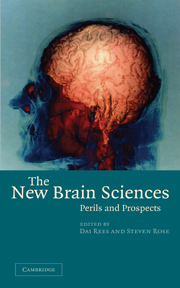Book contents
- Frontmatter
- Contents
- List of contributors
- Part I Introduction: the new brain sciences
- Part II Freedom to change
- Part III Neuroscience and the law
- Part IV Stewardship of the new brain sciences
- 10 The neurosciences: the danger that we will think that we have understood it all
- 11 On dissecting the genetic basis of behaviour and intelligence
- 12 Prospects and perils of stem cell repair of the central nervous system: a brief guide to current science
- 13 The use of human embryonic stem cells for research: an ethical evaluation
- 14 The Prozac story
- 15 Psychopharmacology at the interface between the market and the new biology
- 16 Education in the age of Ritalin
- Part V Conclusion
- References
- Index
12 - Prospects and perils of stem cell repair of the central nervous system: a brief guide to current science
Published online by Cambridge University Press: 08 August 2009
- Frontmatter
- Contents
- List of contributors
- Part I Introduction: the new brain sciences
- Part II Freedom to change
- Part III Neuroscience and the law
- Part IV Stewardship of the new brain sciences
- 10 The neurosciences: the danger that we will think that we have understood it all
- 11 On dissecting the genetic basis of behaviour and intelligence
- 12 Prospects and perils of stem cell repair of the central nervous system: a brief guide to current science
- 13 The use of human embryonic stem cells for research: an ethical evaluation
- 14 The Prozac story
- 15 Psychopharmacology at the interface between the market and the new biology
- 16 Education in the age of Ritalin
- Part V Conclusion
- References
- Index
Summary
WHAT ARE STEM CELLS?
Stem cells are a very special category of building-block in the human body, versatile in that they can not only divide to make copies of themselves but also turn into many mature final forms that no longer divide. For example, stem cells from blood or bone marrow can turn into nerve cells, and those from the brain can turn into blood. There is intense interest in medical applications to restore and renew body parts by inducing stem cell grafts to multiply into new types of tissue needed for repair. This is a particularly exciting prospect for diseases of brain degeneration which are presently incurable. This chapter explains the important concepts in simple terms and offers an account of the extent to which this promise is being realised in practice and of the hurdles that still remain. The chapter to follow considers the ethical issues raised by these actual and potential advances.
WHERE DO STEM CELLS COME FROM?
Stem cells are found in embryonic, fetal and adult brain and body. The fertilised egg is definitively ‘totipotent’, meaning that all other types of cell derive ultimately from it. As the embryo develops into a fetus, stem cells become progressively programmed to become specific cell types, and before their final evolution into mature non-dividing cells they are often called ‘progenitor’ or ‘precursor’ cells.
- Type
- Chapter
- Information
- The New Brain SciencesPerils and Prospects, pp. 195 - 212Publisher: Cambridge University PressPrint publication year: 2004

